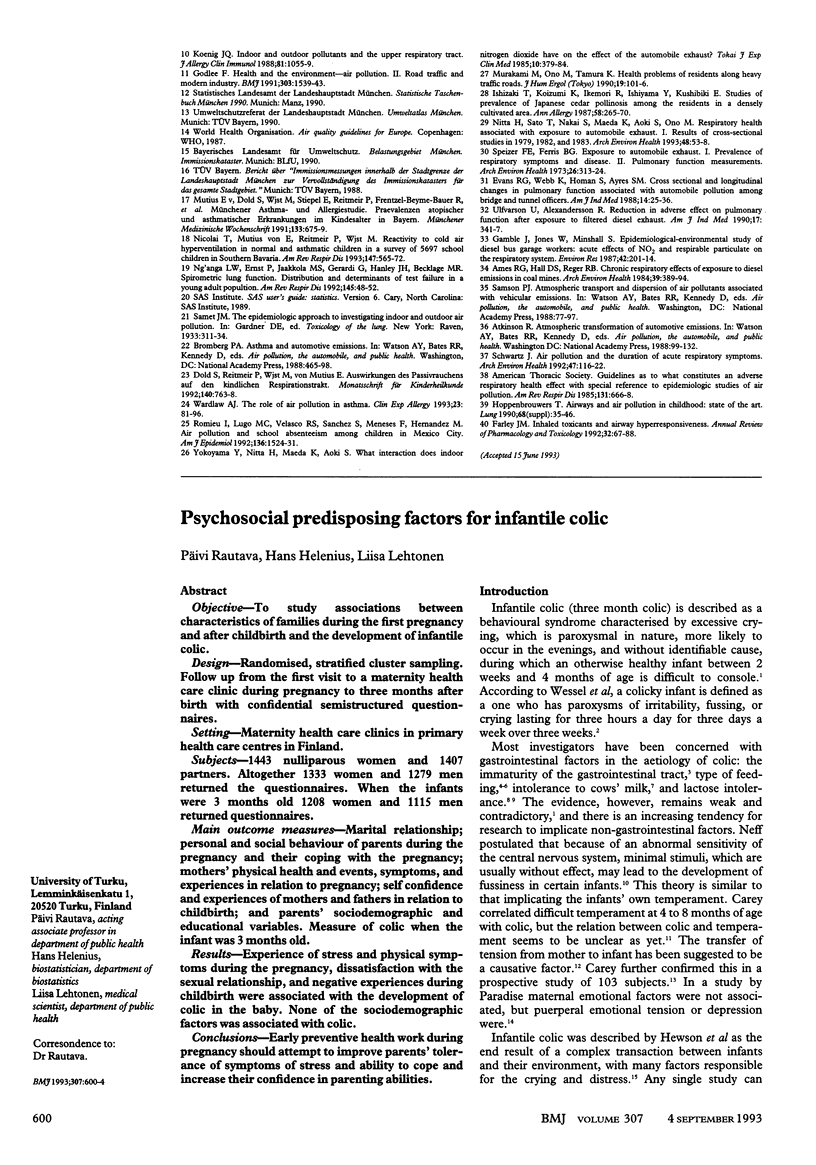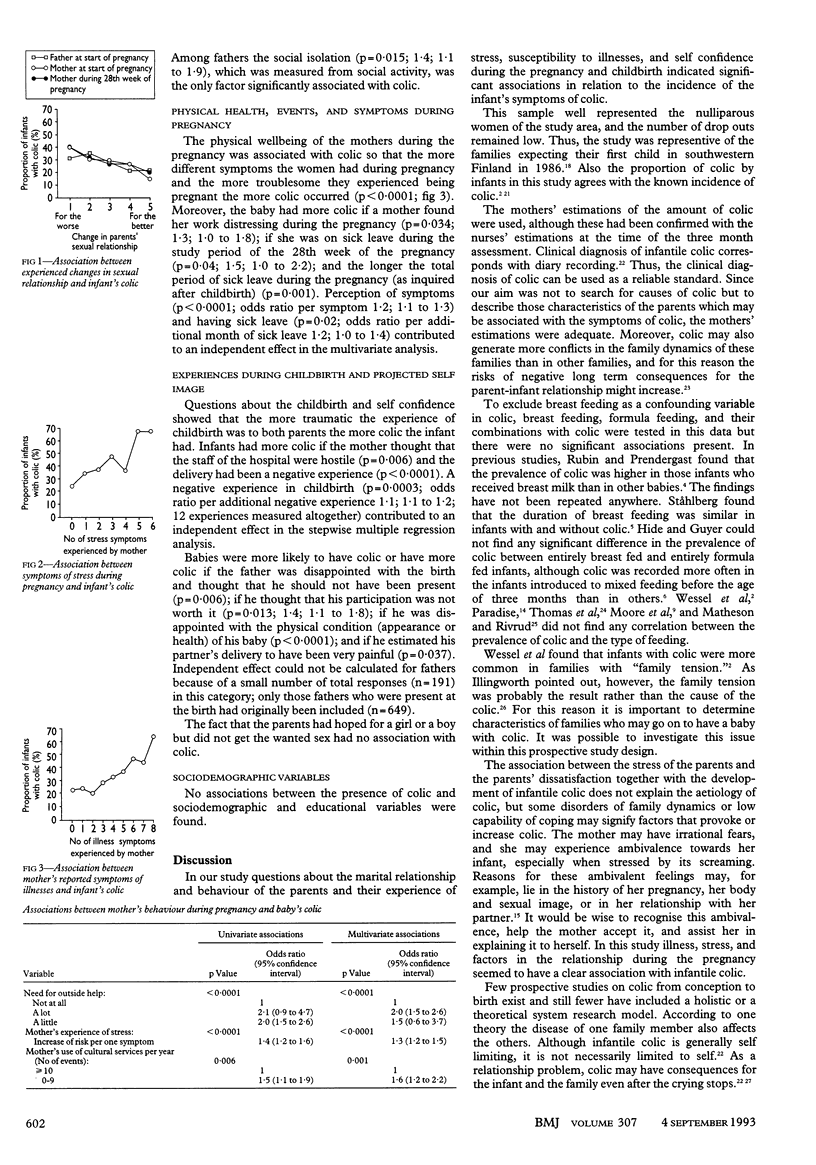Abstract
OBJECTIVE--To study associations between characteristics of families during the first pregnancy and after childbirth and the development of infantile colic. DESIGN--Randomised, stratified cluster sampling. Follow up from the first visit to a maternity health care clinic during pregnancy to three months after birth with confidential semistructured questionnaires. SETTING--Maternity health care clinics in primary health care centres in Finland. SUBJECTS--1443 nulliparous women and 1407 partners. Altogether 1333 women and 1279 men returned the questionnaires. When the infants were 3 months old 1208 women and 1115 men returned questionnaires. MAIN OUTCOME MEASURES--Marital relationship; personal and social behaviour of parents during the pregnancy and their coping with the pregnancy; mothers' physical health and events, symptoms, and experiences in relation to pregnancy; self confidence and experiences of mothers and fathers in relation to childbirth; and parents' sociodemographic and educational variables. Measure of colic when the infant was 3 months old. RESULTS--Experience of stress and physical symptoms during the pregnancy, dissatisfaction with the sexual relationship, and negative experiences during childbirth were associated with the development of colic in the baby. None of the sociodemographic factors was associated with colic. CONCLUSIONS--Early preventive health work during pregnancy should attempt to improve parents' tolerance of symptoms of stress and ability to cope and increase their confidence in parenting abilities.
Full text
PDF




Selected References
These references are in PubMed. This may not be the complete list of references from this article.
- Carey W. B. Clinical applications of infant temperament measurements. J Pediatr. 1972 Oct;81(4):823–828. doi: 10.1016/s0022-3476(72)80115-x. [DOI] [PubMed] [Google Scholar]
- Carey W. B. Maternal anxiety and infantile colic. Is there a relationship? Clin Pediatr (Phila) 1968 Oct;7(10):590–595. doi: 10.1177/000992286800701007. [DOI] [PubMed] [Google Scholar]
- Forsyth B. W. Colic and the effect of changing formulas: a double-blind, multiple-crossover study. J Pediatr. 1989 Oct;115(4):521–526. doi: 10.1016/s0022-3476(89)80274-4. [DOI] [PubMed] [Google Scholar]
- Hewson P., Oberklaid F., Menahem S. Infant colic, distress, and crying. Clin Pediatr (Phila) 1987 Feb;26(2):69–76. doi: 10.1177/000992288702600203. [DOI] [PubMed] [Google Scholar]
- Hide D. W., Guyer B. M. Prevalence of infant colic. Arch Dis Child. 1982 Jul;57(7):559–560. doi: 10.1136/adc.57.7.559. [DOI] [PMC free article] [PubMed] [Google Scholar]
- Hill D. J., Menahem S., Hudson I., Sheffield L., Shelton M., Oberklaid F., Hosking C. S. Charting infant distress: an aid to defining colic. J Pediatr. 1992 Nov;121(5 Pt 1):755–758. doi: 10.1016/s0022-3476(05)81911-0. [DOI] [PubMed] [Google Scholar]
- ILLINGWORTH R. S. Three-months' colic. Arch Dis Child. 1954 Jun;29(145):165–174. doi: 10.1136/adc.29.145.165. [DOI] [PMC free article] [PubMed] [Google Scholar]
- Illingworth R. S. Infantile colic revisited. Arch Dis Child. 1985 Oct;60(10):981–985. doi: 10.1136/adc.60.10.981. [DOI] [PMC free article] [PubMed] [Google Scholar]
- Miller A. R., Barr R. G. Infantile colic. Is it a gut issue? Pediatr Clin North Am. 1991 Dec;38(6):1407–1423. doi: 10.1016/s0031-3955(16)38227-x. [DOI] [PubMed] [Google Scholar]
- Miller J. J., McVeagh P., Fleet G. H., Petocz P., Brand J. C. Breath hydrogen excretion in infants with colic. Arch Dis Child. 1989 May;64(5):725–729. doi: 10.1136/adc.64.5.725. [DOI] [PMC free article] [PubMed] [Google Scholar]
- Moore D. J., Robb T. A., Davidson G. P. Breath hydrogen response to milk containing lactose in colicky and noncolicky infants. J Pediatr. 1988 Dec;113(6):979–984. doi: 10.1016/s0022-3476(88)80567-5. [DOI] [PubMed] [Google Scholar]
- Paradise J. L. Maternal and other factors in the etiology of infantile colic. Report of a prospective study of 146 infants. JAMA. 1966 Jul 18;197(3):191–199. doi: 10.1001/jama.1966.03110030085031. [DOI] [PubMed] [Google Scholar]
- Rautava P., Sillanpä M. The Finnish Family Competence Study: knowledge of childbirth of nulliparous women seen at maternity health care clinics. J Epidemiol Community Health. 1989 Sep;43(3):253–260. doi: 10.1136/jech.43.3.253. [DOI] [PMC free article] [PubMed] [Google Scholar]
- Rautava P. The Finnish family competence study: characteristics of pregnant women with low childbirth knowledge. Soc Sci Med. 1989;29(9):1105–1109. doi: 10.1016/0277-9536(89)90023-3. [DOI] [PubMed] [Google Scholar]
- Rubin S. P., Prendergast M. Infantile colic: incidence and treatment in a Norfolk community. Child Care Health Dev. 1984 Jul-Aug;10(4):219–226. doi: 10.1111/j.1365-2214.1984.tb00181.x. [DOI] [PubMed] [Google Scholar]
- Thomas D. W., McGilligan K., Eisenberg L. D., Lieberman H. M., Rissman E. M. Infantile colic and type of milk feeding. Am J Dis Child. 1987 Apr;141(4):451–453. doi: 10.1001/archpedi.1987.04460040109028. [DOI] [PubMed] [Google Scholar]
- Thompson P. E., Harris C. C., Bitowski B. E. Effects of infant colic on the family: implications for practice. Issues Compr Pediatr Nurs. 1986;9(4):273–285. doi: 10.3109/01460868609009781. [DOI] [PubMed] [Google Scholar]
- WESSEL M. A., COBB J. C., JACKSON E. B., HARRIS G. S., Jr, DETWILER A. C. Paroxysmal fussing in infancy, sometimes called colic. Pediatrics. 1954 Nov;14(5):421–435. [PubMed] [Google Scholar]


